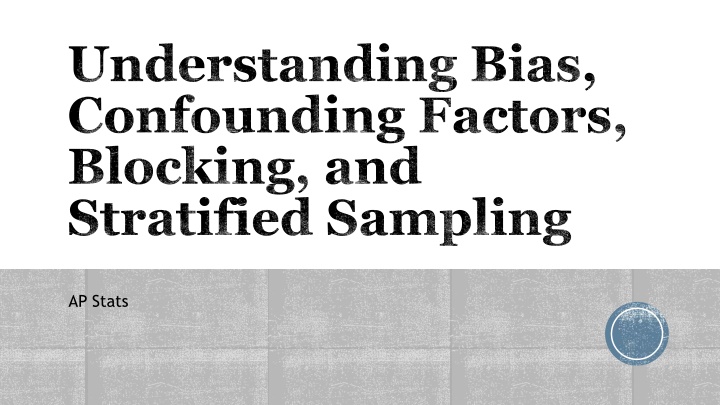
Understanding Bias, Confounding Factors, Blocking, and Stratified Sampling in AP Statistics
Explore the concepts of bias, confounding factors, blocking, and stratified sampling in AP Statistics. Understand how bias can skew results, the impact of confounding factors on relationships, and methods to control for confounders. Learn how blocking ensures fair comparisons in experiments and how stratified sampling divides populations for representative sampling.
Download Presentation

Please find below an Image/Link to download the presentation.
The content on the website is provided AS IS for your information and personal use only. It may not be sold, licensed, or shared on other websites without obtaining consent from the author. If you encounter any issues during the download, it is possible that the publisher has removed the file from their server.
You are allowed to download the files provided on this website for personal or commercial use, subject to the condition that they are used lawfully. All files are the property of their respective owners.
The content on the website is provided AS IS for your information and personal use only. It may not be sold, licensed, or shared on other websites without obtaining consent from the author.
E N D
Presentation Transcript
Understanding Bias, Confounding Factors, Blocking, and Stratified Sampling AP Stats
Bias Definition: Bias refers to a systematic error that skews results in one direction. Types of Bias: Selection Bias: Non-representative sample, such as surveying gym-goers to assess fitness levels. Nonresponse Bias: Non-respondents differ from respondents, leading to skewed opinions. Response Bias: Participants provide inaccurate answers, often due to social pressure or question phrasing. Measurement Bias: Flawed tools or methods cause consistent errors, like a miscalibrated scale.
Impact of Bias Bias distorts the truth and can lead to wrong conclusions. Example: Conducting a survey at a political rally introduces selection bias because the sample isn t representative. Effect: Biased data can lead to incorrect decisions, such as passing laws based on skewed opinions.
Confounding Factors Definition: A confounding factor is a variable that affects both the independent and dependent variables, obscuring relationships. Example: Ice cream consumption and drowning incidents are both influenced by hot weather, a confounding factor. Effect: Confounders can lead to false causality or over/underestimating relationships.
Controlling Confounding Factors Methods to control for confounding factors: Randomization: Ensures confounders are evenly distributed. Stratification: Divides subjects into subgroups based on confounders. Statistical Adjustment: Regression analysis adjusts for confounders in results.
Blocking Definition: Blocking is used in experiments to group subjects by confounding factors, ensuring fair comparisons. Example: In a blood pressure medication trial, subjects are divided into age blocks and then randomly assigned treatments. Effect: Blocking prevents confounders from distorting treatment effects.
Stratified Sampling Definition: Stratified sampling divides a population into subgroups (strata) and randomly samples from each to ensure all key groups are represented. Example: A school survey randomly samples students from each grade level to represent the entire student body.
Blocking vs. Stratified Sampling Blocking is used in experiments to control confounders by grouping similar individuals. Stratified sampling is used in surveys to ensure all subgroups of a population are represented. Example: Blocking controls for age in a clinical trial, while stratified sampling ensures all grades are surveyed in a school.
Conclusion By using these techniques, we can improve the accuracy and reliability of statistical studies and experiments. Bias and confounding factors distort results, making it hard to draw accurate conclusions. Blocking and stratified sampling help control for these distortions.
